

Berkshelf. Who Were the Religious Leaders of Jesus's Day? The Priesthood In first century Palestine there was no separation between church and state.

The priests at the temple in Jerusalem not only officiated over the religious life of the Jews, they were also rulers and judges. Herod, who was himself a pawn of Rome, had his own pawns installed in the Jewish priesthood. Getting started with Chef report and exception handlers. This post is for people who want to use or write their first Chef report handler, but aren’t sure where to begin.
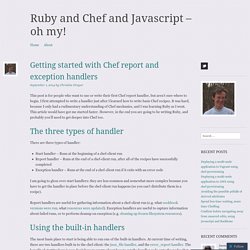
I first attempted to write a handler just after I learned how to write basic Chef recipes. It was hard, because I only had a rudimentary understanding of Chef mechanics, and I was learning Ruby as I went. About Attributes. An attribute is a specific detail about a node.
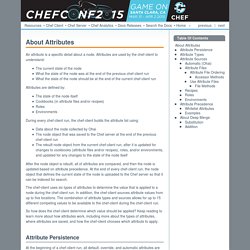
Attributes are used by the chef-client to understand: The current state of the nodeWhat the state of the node was at the end of the previous chef-client runWhat the state of the node should be at the end of the current chef-client run Attributes are defined by: The state of the node itselfCookbooks (in attribute files and/or recipes)RolesEnvironments During every chef-client run, the chef-client builds the attribute list using: Opscode-cookbooks/chef_handler. Understanding attributes · pikesley/learn-yourself-some-chef Wiki. One of the things I found most baffling when picking up Chef was attribute precedence.
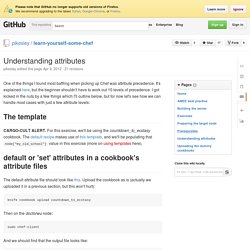
It's explained here, but the beginner shouldn't have to work out 10 levels of precedence. I got kicked in the nuts by a few things which I'll outline below, but for now let's see how we can handle most cases with just a few attribute levels: The template CARGO-CULT ALERT. For this exercise, we'll be using the countdown_to_ecstasy cookbook. About Handlers. Use a handler to identify situations that arise during a chef-client run, and then tell the chef-client how to handle these situations when they occur.
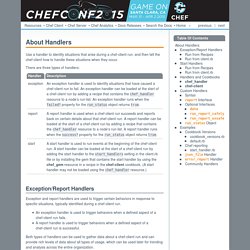
Exception/Report Handlers Exception and report handlers are used to trigger certain behaviors in response to specific situations, typically identified during a chef-client run. An exception handler is used to trigger behaviors when a defined aspect of a chef-client run fails.A report handler is used to trigger behaviors when a defined aspect of a chef-client run is successful.
Both types of handlers can be used to gather data about a chef-client run and can provide rich levels of data about all types of usage, which can be used later for trending and analysis across the entire organization. Exception and report handlers are made available to the chef-client run in one of the following ways: Ruby Tutorial with Code Samples. Chef Server. Learning Chef - Part 1 - Nathen Harvey. Learning Chef – Mathias Lafeldt. September 11, 2012 I’m currently in the process of learning Chef – the infrastructure automation framework by Opscode – and wanted to share some of the things I’ve picked up along the way.
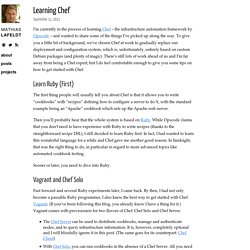
To give you a little bit of background, we’ve chosen Chef at work to gradually replace our deployment and configuration system, which is, unfortunately, entirely based on custom Debian packages (and plenty of magic). There’s still lots of work ahead of us and I’m far away from being a Chef expert, but I do feel comfortable enough to give you some tips on how to get started with Chef. Learn Ruby (First) The first thing people will usually tell you about Chef is that it allows you to write “cookbooks” with “recipes” defining how to configure a server to do X, with the standard example being an “Apache” cookbook which sets up the Apache web server.
Style Guide. Ruby Basics This section covers the basics of Ruby.
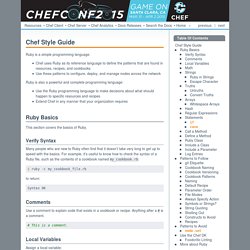
Verify Syntax Many people who are new to Ruby often find that it doesn’t take very long to get up to speed with the basics. For example, it’s useful to know how to check the syntax of a Ruby file, such as the contents of a cookbook named my_cookbook.rb: $ ruby -c my_cookbook_file.rb. DevOps Cafe Podcast & Videos - Show Notes. Berkshelf and Chef Cookbook Dependencies. Greetings, readers!

I continue delving into the specifics of management automation and configuration, while also trying to share my community experience. In this article, I will continue talking about the automation tool for solving Chef cookbook dependencies, namely Berkshelf. A knife.rb for our time - Automate All the Things! Ohai Chefs!
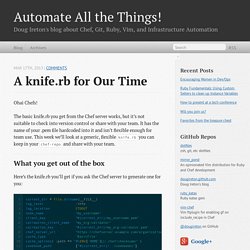
The basic knife.rb you get from the Chef server works, but it’s not suitable to check into version control or share with your team. It has the name of your .pem file hardcoded into it and isn’t flexible enough for team use. This week we’ll look at a generic, flexible knife.rb you can keep in your chef-repo and share with your team. Chef-shell (executable) — Chef Docs. Chef-shell is a recipe debugging tool that allows the use of breakpoints within recipes. chef-shell runs as an Interactive Ruby (IRb) session. chef-shell supports both recipe and attribute file syntax, as well as interactive debugging features.

The chef-shell executable is run as a command-line tool. Modes chef-shell is tool that is run using an Interactive Ruby (IRb) session. chef-shell currently supports recipe and attribute file syntax, as well as interactive debugging features. chef-shell has three run modes: Options. Getting Started Writing Chef Cookbooks the Berkshelf Way, Part 1 - Mischa Taylor's Coding Blog. Updated Jan 29th, 2014 Per Seth Vargo, Note about the future of vagrant-berkshelf Updated December 27th, 2013 Being more prescriptive about the necessary Ruby 1.9.x environment Bumped VirtualBox from version 4.3.4 to 4.3.6 Bumped vagrant-berkshelf plugin from version 1.3.6 to 1.3.7 Bumped vagrant-omnibus plugin from version 1.1.2 to 1.2.1 Added alternate command lines for Windows, as necessary Debate on symbols vs strings is an unnecessary distraction, removed this section Per Dan Patrick introducing the concept of cookbook_file before template, as this was confusing Updated December 15th, 2013.
Bootstrap a Node — Chef Docs. A node is any physical, virtual, or cloud machine that is configured to be maintained by a chef-client. There are two ways to install the chef-client on a node so that it may be maintained by the chef-client: knife bootstrap. Andy_Hawkins_Introduction_intoChef_05. Chef Style Guide — chef-client. Customizing_Chef. Style Guide — Chef Docs. Knife client — Chef Docs. The knife client subcommand is used to manage an API client list and their associated RSA public key-pairs.
This allows authentication requests to be made to the Chef server by any entity that uses the Chef server API, such as the chef-client and knife. Note Review the list of common options available to this (and all) knife subcommands and plugins. Installation/OS Specific Notes/Installing Amanda on Mac OS X. From The Open Source Backup Wiki (Amanda, MySQL Backup, BackupPC) Amanda has been tested on Mac OS X Panther (10.3), Tiger (10.4), Leopard (10.5) and Snow Leopard (10.6). With Panther, the built-in tar does not record extended filesystem attributes (resource forks, finder flags, ACLs, and so on), so users who want to be able to restore those attributes will need to do some extra work (see below).
Knife client — Chef Docs. Networking - Vagrant Documentation. In order to access the Vagrant environment created, Vagrant exposes some high-level networking options for things such as forwarded ports, connecting to a public network, or creating a private network. The high-level networking options are meant to define an abstraction that works across multiple providers. This means that you can take your Vagrantfile you used to spin up a VirtualBox machine and you can reasonably expect that Vagrantfile to behave the same with something like VMware. You should first read the basic usage page and then continue by reading the documentation for a specific networking primitive by following the navigation to the left.
In some cases, these options are too high-level, and you may want to more finely tune and configure the network interfaces of the underlying machine. Most providers expose provider-specific configuration to do this, so please read the documentation for your specific provider to see what options are available. Knife configure — Chef Docs. Foodcritic - A lint tool for your Opscode Chef cookbooks. Bootstrap a Node — Chef Docs. Configuration Management for Windows. Installing Chef — Ceph documentation. Foodcritic - A lint tool for your Opscode Chef cookbooks. Berkshelf. A knife.rb for our time - Automate All the Things! Infrastructure automation by example - Practicing Ruby, Issue 7.6. How To Use Roles and Environments in Chef to Control Server Configurations. Git - the simple guide - no deep shit! Ruby DSL Handbook - the ebook about creating Ruby code that speaks your language while avoiding metaprogramming hell. Written by Jim Gay.
Cooking with Chef, part 2. About the Recipe DSL — Chef Docs. How To Create Simple Chef Cookbooks to Manage Infrastructure on Ubuntu. Iptables/README.md at master · opscode-cookbooks/iptables. A Brief Chef Tutorial (From Concentrate) - A Fistful of Servers. Blog Archive - Food Fight. Automating Web App Deployments with Opscode Chef and iControl. Infrastructure automation by example - Practicing Ruby, Issue 7.6. Chef for DevOps - an Introduction. CookbookUpload — Documentation for opscode/chef (master) Infrastructure automation by example - Practicing Ruby, Issue 7.6. Day 24 - Twelve things you may not know about Chef. Amazon Web Services Sign In. Authorizing Inbound Traffic for Your Linux Instances. First steps with Chef - Getting started with Chef. What Is Amazon EC2? - Amazon Elastic Compute Cloud. Connecting to Your Linux Instance Using SSH - Amazon Elastic Compute Cloud. An Overview of Chef — Chef Docs. Walkthrough: Register an Instance from Your Workstation - AWS OpsWorks.
Configure a package and service - Learn the Chef basics on Red Hat Enterprise Linux - Error. Cooking Infrastructure by Chef. About the Recipe DSL. Sethvargo/chef-sugar. Why Chef Should Manage Deploying Your Application.